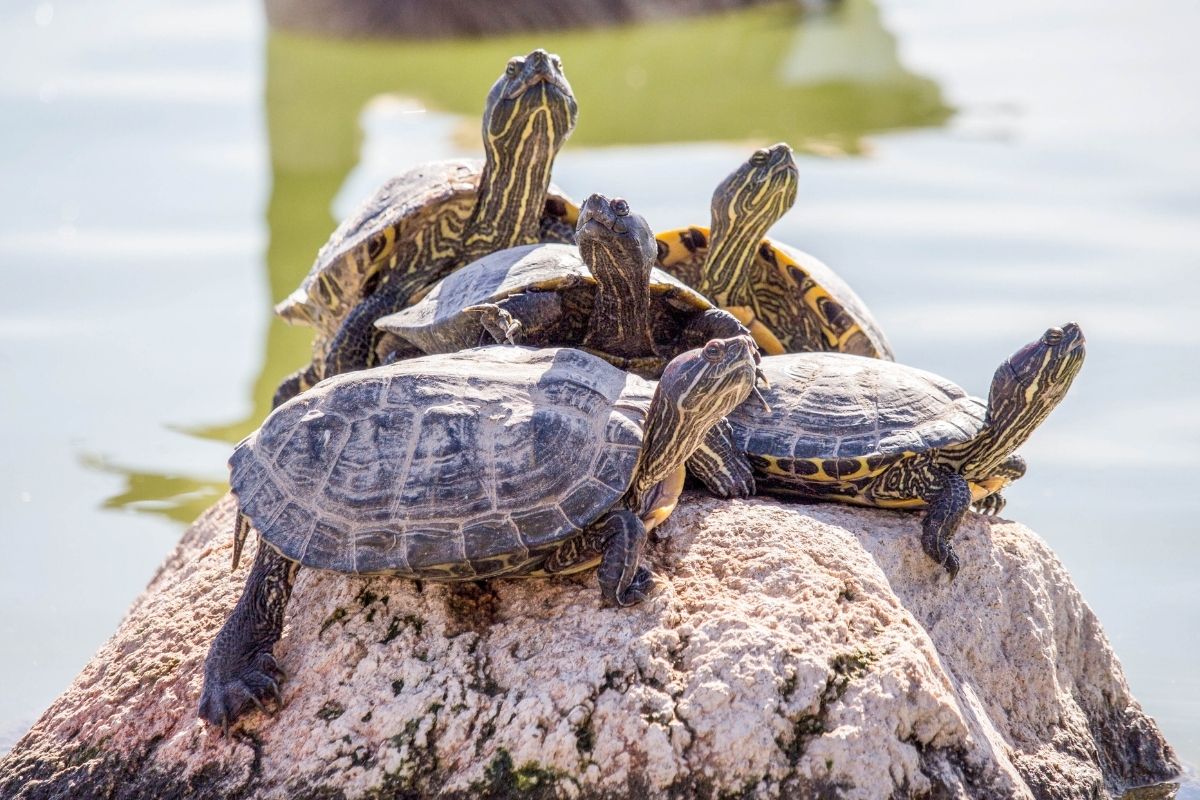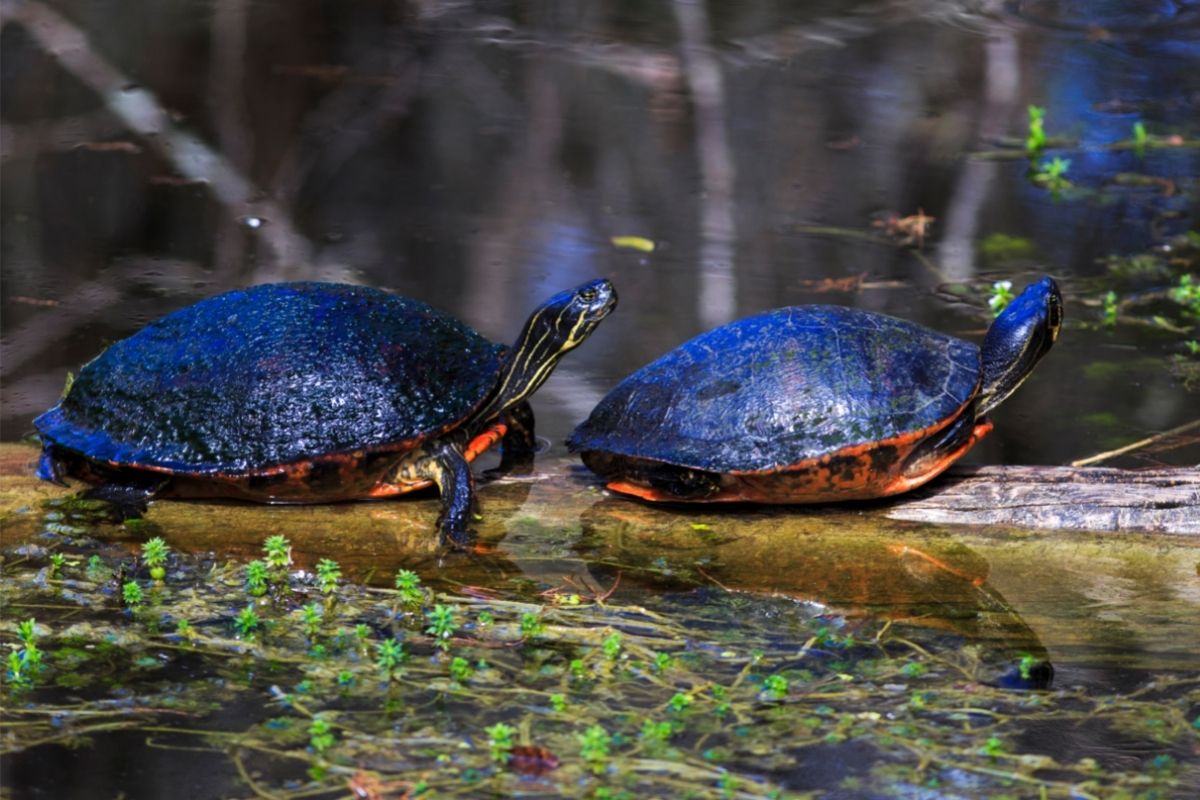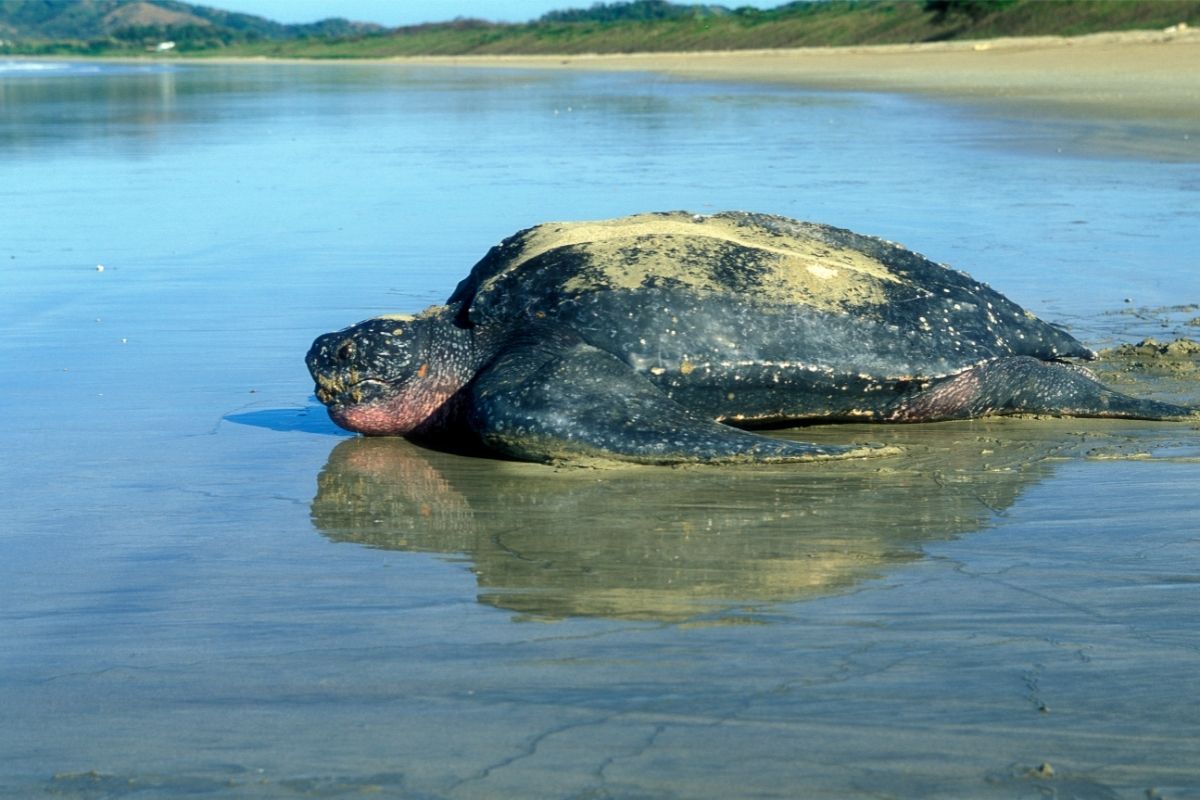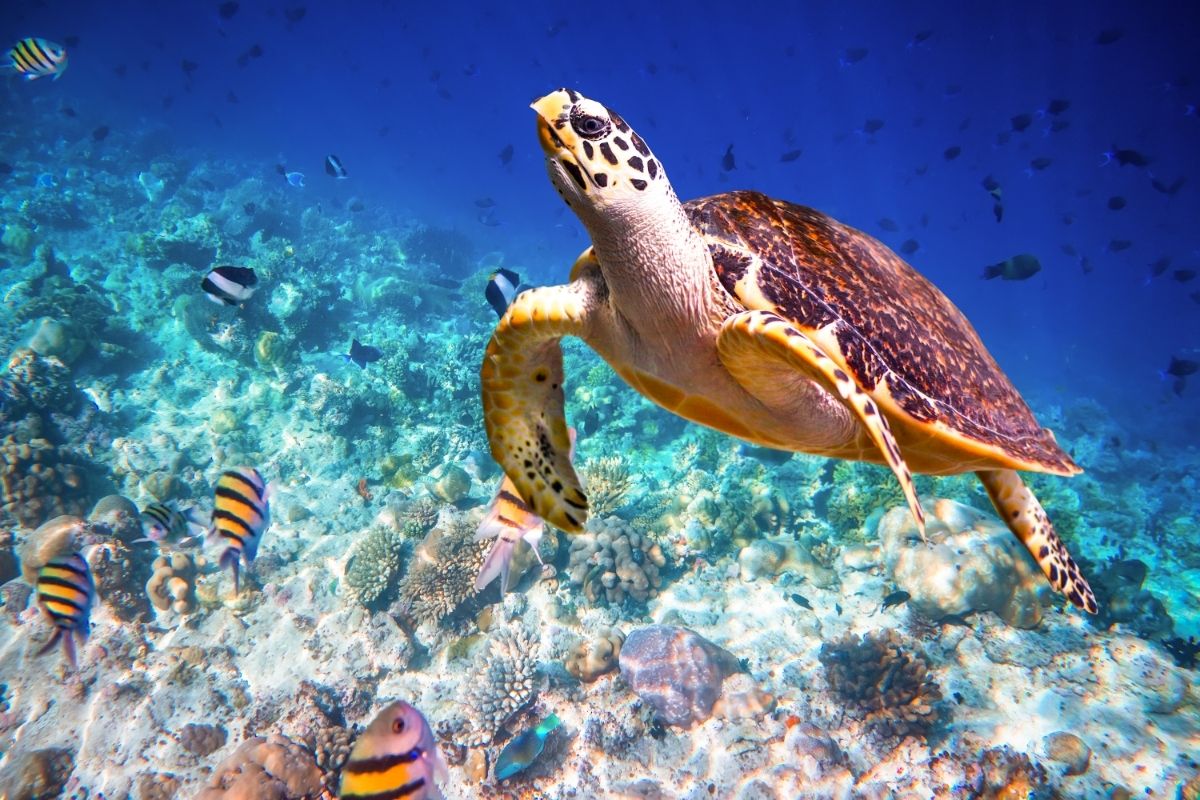Turtles are becoming more and more popular as pets over the years as people are learning how interesting and diverse they are. The needs of these turtles vary greatly depending on their own individuality as well as the type of species that they belong to.
Knowing what type of turtle you have will ensure that you can give them everything that they need because if you get it wrong, it can lead to a lot of health problems and even death, as well as an overall poor quality of life.

Land Tortoise
We will begin with land tortoises which, as the name suggests, are only found on land. The main difference between turtles and tortoises is that the latter can only live on land while turtles can’t.
Their shells are shaped like a high dome and are not as light and streamlined as turtle shells.
A good way to identify a tortoise is by looking at their feet because they have short legs that look a bit like those of an elephant, and when they walk, they walk on their toes.
Some common types of tortoises include the following:
Greek Tortoise
Also known as Testudo graeca, the Greek tortoise has quite a relaxed and friendly disposition as well as a very beautiful shell which makes them very popular as pets.
They are very accustomed to being kept in captivity and since they can be found living in various different environments in the wild, they do not require a specific climate as long as it is hot and dry enough.
They can reach lengths of up to eight inches when they are fully grown but can sometimes reach up to 11 inches, but this is quite rare. Since they are not too big, it makes the Greek tortoise easy to manage as pets, and despite their size, they can still live up to 200 years.
Russian Tortoise
In addition to the Greek tortoise, the Russian tortoise is another popular choice for having as a pet. One of the things that makes them so popular is because they are easy to care for and are interesting to look at, with unique claws for digging.
The Russian Tortoise is also more active than the average tortoise, making them fascinating to watch as they go about their business.
Their shell is large and domed in shape with short, thick legs and rough skin that is tan and tough enough to protect them. They have patches of darker color on their head and legs.
The upper part of the shell is known as the carapace and is usually tan, brown, black, or olive green in color with tan ridges and darker scutes.
The plastron is the term given to the bottom part of the shell, which is also quite dark on the Russian tortoise, with black being the main color with a bit of brown splashed in throughout.
Indian Star Tortoise
The Indian star tortoise is medium and is native to the hot and dry deserts of Sri Lanka and India. This tortoise got its name from the fact that it has patterns on its high-domed shell that looks like stars.
Because of its beautiful shell, the Indian star tortoise is very popular in the exotic pet trade. Still, the shell doesn’t just look like it is pretty as it is also designed to offer the tortoise disguise from predators in the wild.
Red Footed Tortoise
This tortoise is about the same size as the Indian star tortoise and is found in South and Central America. The concave shell has a bumpy texture that is most commonly brown, black, or gray and the skin of this tortoise is primarily black.
Red marks may be present on their head, tail, and legs which can also be orange or yellow.
The interesting thing about this particular species of tortoise is that they communicate with each other by making clucking sounds, similar to that of a chicken which is unique as tortoises and turtles don’t usually make any sounds.
They make these clucking sounds when they are courting or mating with others as well as when they are foraging for food as juveniles.
Freshwater Turtles

The most popular kind of turtle that you have likely come across has been a freshwater turtle. They are typically the smallest among the other turtle species and like to spend the majority of their time in the water as aquatic beings.
The exception to this fact is the box turtle, as they tend to spend more time on land than in the water, but other types of freshwater turtles, such as the Japanese pond turtle, can be submerged in water for months on end.
Here are some of the most common types of freshwater turtles:
Snapping Turtle
The snapping turtle is one of the most aggressive and dangerous turtles out there and will not hesitate to attack you if you get too close. Therefore, if you come across one of these turtles in the wild, you must leave them alone, and whatever you do – do not approach them!
Their jaws are very powerful and are capable of biting off your toe or finger completely, and pairing this with their flexible neck and head is a recipe for disaster on your end.
They are built to be muscular with a ridged carapace and pronounced ridges that can either be light brown or black in color.
Cooter
These types of turtles are some of the biggest types of pond turtles native to North America and are also very popular as pets as they are very pretty and can live with other turtles.
The River cooter is about 11 inches long on average and has brown, black, or yellow markings on its long, flat shell, with males having a flatter shell than female river cooters.
You can also tell the difference between a male and female cooter by comparing their size, as the males are usually smaller.
Another type of cooter is the Florida red-bellied cooter which got its name from the red color on the underside of its body. They have red striped on their carapace as well. They are calm and generally docile but can grow to be very big which makes them not as practical to keep as pets.
The Northern red-bellied cooter is slightly different from the Florida red-bellied cooter because it has a carapace that is olive with red marks on it with a red plastron.
You can tell what red-bellied cooter you have come across by knowing which region they were found in.
Softshell Turtle
The softshell turtle is another aggressive and dangerous type of turtle, and you should not let the name fool you because these animals are still hardy and will put up a fight if they feel threatened by you.
Their shells have a leathery texture and do not have any scutes on them like other turtles.
They also don’t have any bumps or spines on their shell which are used on other species to tell them apart from one another.
Their necks are long with a streamlined head on the end of it, which can be very quick and flexible when it needs to be, especially when the turtle is hunting.
The snout of the softshell turtle is pointed and has nostrils placed on top of it which gives the turtle the ability to breathe when it is buried in the sand, mud, or shallow water.
Box turtle
Even though box turtles are technically turtles, they seem to behave much more like a tortoise because they spend a lot more time on land than they do in the water.
They also have shells that are more domed than other turtles, which have a lovely yellow pattern of speckles and spots depending on the type of box turtle.
The box turtle is quite small and usually only reaches lengths of up to seven inches.
Map Turtle
The map turtle is aquatic and is native to North America, with 14 different recognized species. Each of these 14 variations of the map turtle has different coloring ranging from browns, blacks, and light greens; some species even have yellow patterns on the skin as well as on their shell.
They have a distinguished shell that has a ridge pointing down the back, making it easier to decipher as a map turtle.
Wood Turtle
As far as turtles go, the wood turtle is medium and lives a semiaquatic lifestyle in North America. The carapace is gray, tan, or brown and has a ridge in the center known as a keel which is made from ridges and grooves that follow a pyramidal pattern.
The plastron is yellow with dark patches but can also have yellow speckles as well, with the top of their head having a black or dark gray color.
Their chin, neck, and legs have a lovely red, orange, and yellow stripey pattern that can span the bottom of the jaw on some wood turtles.
Sea Turtles

As the name suggests, sea turtles are found in the sea and are usually much larger than tortoises and freshwater turtles. The only time that sea turtles come out of the sea is when they go to beaches to lay their eggs.
You can easily tell what a sea turtle is by looking at its legs, as they will be flippers instead of feet.
Here are some of the most common types of sea turtles:
Leatherback Sea Turtle
The leatherback sea turtle is a very big turtle that has even earned its name as the biggest sea turtle in the world. They can grow to be as long as eight feet in length, and the largest leatherback ever recorded weighed 2,000 pounds!
The name of this sea turtle comes from the fact that its shell has a texture similar to leather which is made from lots of small bones covered in a tough and rubbery skin.
There is one clear ridge that you can see run down the back of this turtle, but there are also two smaller ridges on either side.
The color of the leatherback sea turtle is primarily dark brown or black with pale markings throughout its body. When they are younger, the leatherback will also have lighter markings on their flippers.
Atlantic Ridley Sea Turtle
On the opposite side of the spectrum from the leatherback sea turtle, the Atlantic Ridley sea turtle is the smallest sea turtle in the world. They have a beak that has a slight hook and a triangular-shaped head.
When they are young, the Atlantic Ridley sea turtle has dark coloring, but as they get older, these colors will change to be a more gray or green shade, with the bottom of the shell being yellow.
The carapace is the same width as it has length, and there are claws on both of the front flippers.
Hawksbill Sea Turtle
The pointed beck of this turtle is what earned it the name of the hawksbill sea turtle. They have scales that overlap one another that create a serrated edge on the shell which has a beautiful array of colors and patterns.
Unfortunately, this shell is what has made the hawksbill sea turtle so endangered as they are often hunted for this shell which has a pattern named after it is known as ‘tortoise shell’, used mostly in trinkets and jewelry.
How to Tell if It Is a Tortoise, Freshwater Turtle, or Sea Turtle

Obviously, if the turtle that you found has flippers instead of feet, it is safe to say that they are sea turtles as they spend the majority of their time in the sea.
If you do not see flippers, it may either be a tortoise or a freshwater turtle. The feet of a tortoise look like elephant feet, and they walk on their tiptoes instead of the flat part of the foot like freshwater turtles do.
Plastron Shape
Look at the shape of the plastron, if it is a snapping turtle, you will be able to see a saw-like tail that is quite long, and the plastron will be cross-shaped that cover just a bit of its underside.
Shell
If the shape of the shell is soft and slightly malleable and the turtle has a long snout, it is likely a softshell turtle.
Scutes
A turtle with 11 scutes and the pectoral scute has a square shape with visible skin between the scutes then it could be a musk turtle which is a freshwater turtle that has the ability to produce a foul odor with its scent glands when threatened, like a skunk.
However, if the pectoral scute is triangular instead of square, and you can’t really see any skin in between the scutes, then it could be a mud turtle.
If you can see 12 scutes on the turtle’s shell, then you might have an eastern box turtle on your hands as they have 12 scutes as well as feet that look similar to that of an elephant.
Feet
Sometimes the toes will either be webbed or unwebbed, so it’s good to make a note of this as you complete the puzzle as to what turtle you have as a tortoise does not have webbed feet.
If you have an eastern box turtle, their toes should not be webbed but other turtles that are more aquatic will have webbed feet.
Keel
Take note of if the turtle’s carapace has a keel on it that has ridges and grooves with a pyramidal pattern, and then look at the tail of the turtle. If the tail is shorter than the carapace, then you should read through the next section that covers the neck.
If the carapace is flat and the keel has a pyramidal pattern, then it is most likely a wood turtle. If this is the case, then the plastron should be primarily yellow with black spots as well on the corners of the scutes on the underside.
It should also have a tail that is longer than the carapace.
Neck
When it comes to the neck, a chicken turtle is distinguished if the neck can stretch to be longer or just as long as the carapace. The chicken turtle is quite rare and is found in the Southeast United States.
Carapace
If the grooves on the carapace are in concentric circles on the scutes, it might be a diamondback terrapin which is a species with gray skin and black spots.
A red-eared slider and a map turtle both have a serrated edge on their carapace, but the red-eared slider has a keel that looks a bit like a saw.
A carapace that is smooth and has no serrated edges means that it could be an Eastern Painted turtle, a bog turtle, or a spotted turtle.
Jaws
An upper jaw that has notches in it with small cusps on both sides is a sign it may be an eastern-painted turtle; you should also look to see if there are red/orange lines that are spread across the carapace as this also points toward an eastern painted turtle.
Look at the Carapace Again
Take a look at the carapace again and see if there is a keel. If there is no keel and the turtle has a patch of orange underneath its eyes with a black carapace and yellow spots, then it is possibly a spotted turtle.
But if the carapace has a keel and it is brown with no markings, you could have a bog of a turtle that also has an orange patch on its head and neck.
Head and Neck
If there are less than 16 stripes on the turtle’s neck, this points toward it being a cooter or slider, but if there are more than 15 stripes on the neck, it could be a map turtle.
A small patch of yellow behind the eyes, in addition to lined contours on the carapace, signifies that it is a map turtle.
Identifying Baby Turtles
When it comes to baby turtles, the way that these species can be identified is quite different as they change in colors and markings as they age.
It also makes it more difficult because seeing the size of the adult turtle and tortoise is a big help with identifying what species it is.
In most cases, when a turtle or tortoise is a hatchling, it will mimic how it will look as an adult, but this varies between species. When baby turtles are fresh out of the egg, they will have an egg tooth on their nose, which they use to break out of the shell from the inside.
This tooth falls off within six weeks of hatching.
As hatchlings, their colors will be much brighter in comparison to their adult counterparts and will also have less wear and tear on their skin and shell caused by the environment and predators.
Frequently Asked Questions
How Can You Tell if a Turtle Has a Keel?
By looking at its shell, you can tell if a turtle has a keel. If you see a ridge that spreads from the front to the back of the turtle either by itself or along with other ridges, then those are keels. They can vary in shape, size, and amount depending on the species.
Is My Turtle a Male or a Female?
If your turtle has a short and skinny tail, then your turtle is a female, but if the tail is long and thick, then it is a male. A male turtle will also have a vent which is also known as a cloaca, placed further down the tail towards the tip in comparison to females.
Summary
We have covered the most common types of tortoises and turtles so that you can use their descriptions to compare that to the ones that you are trying to identify.
If your turtle or tortoise is not fitting the colors, markings, shapes, and sizes of these species that we talk about though, you can use our step-by-step guide to help you get to the bottom of what species you have.
It is important to be aware of what turtle or tortoise you have so that you can do further research and know everything there is to know about how to give them the care that they need for a long and happy life.
